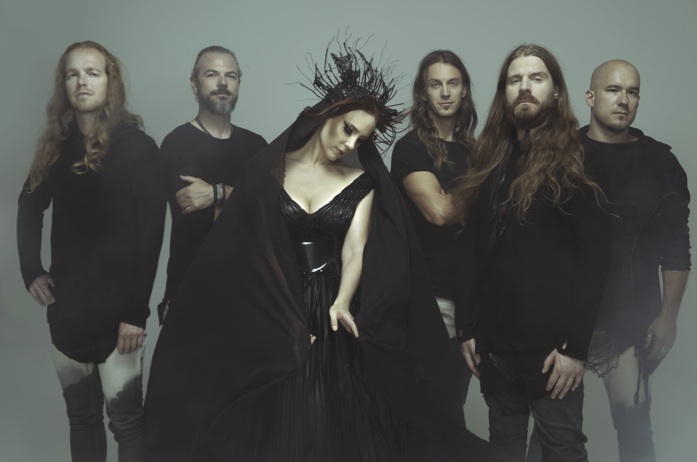Symphonic Metal
The term “Symphonic Metal” is used to designate any Metal band that makes use of Symphonic or orchestral elements, that is, elements that are either borrowed from Classical music or opera-like vocals, instrumentation that includes acoustic guitars and different types of keyboards, rather than relying exclusively on electric guitars; asymmetrical poetic rhythms such as 5/4 and 7/8, and classical thematic material, in addition to characteristically powerful Heavy Metal riffs.
Musical characteristics
The main musical influences of Symphonic Metal are initially Gothic Metal and Classical music.
Keyboards are typically the focal point of the music. While other instruments typically play relatively simple roles, keyboard parts can be complex and technically challenging, often played in various classical styles, including full orchestral arrangements.
A real orchestra is sometimes used, both live and in the studio, to similar effect.

It’s harder to generalize about this style’s guitar and bass work. As with Gothic Metal, this can often be described as a synthesis of other Rock and Metal styles, with elements of Black Metal, Death Metal, Power Metal and Progressive Metal being the most common; but unlike Gothic Metal, elements of Classical music are often present. Many of these bands, at least, sometimes use these instruments (as well as lead vocals) to play simple, catchy melodies, which make symphonic Metal (along with Power Metal, which has this characteristic as well) one of the most accessible subgenres of Metal today.
The songs are often highly atmospheric, although more upbeat than those in other Metal subgenres. Particularly important in creating mood and atmosphere is the choice of keyboard sounds.
The keyboard is the main instrument used in Symphonic Metal.
The lyrics cover a wide range of themes. As with two of symphonic Metal’s most important influences, Power Metal and Opera, fantasy and mythological themes are common. Concept albums styled after operas or epic poems are equally common.
Bands of this genre often feature a female vocalist, most often a soprano. There is sometimes a second male vocalist, as is also common in Gothic Metal.
Roaring, Death Metal-style vocals are rare but not unknown. Even additional support and the inclusion of a full choir are sometimes employed. Male vocalists are more common in the Symphonic Power Metal category.
Sometimes, the vocalist performs classical singing with an opera style. These bands are referred to as Opera Symphonic Metal, for example, Nightwish (when the vocalist was Tarja Turunen) and the band Within Temptation with vocalist Sharon den Adel) who previously sang with Tarja. Haggard, Therion, Operatika, Dremora, Dol Ammad, Hamen, Visions of Atlantis, Aesma Daeva. The opera style is not exclusively linked to symphonic Metal; it also appears in Avant-garde, Progressive, Gothic, and Melodic Death.
The roots of Symphonic Metal are initially found in Death Metal and Gothic Metal bands, which make some use of symphonic elements in their music. Therion’s use of a live orchestra and classical compositional techniques was particularly important. Gradually, these elements became a more important part of Therion’s music than their Death Metal roots.
Another key early influence was Finnish Progressive Metal band Waltari’s album “Yeah! Yeah! Die! Die!” Death Metal Symphony in Deep C.
Haggard, Nightwish and Within Temptation both released their debut album in 1997, each heavily influenced by Therion’s symphonics. Within Temptation was more influenced by Gothic Metal and therefore musically simpler than the more Power Metal-influenced Nightwish, but both bands shared two main elements of symphonic Metal – powerful female vocals from Tarja Turunen and Sharon den Adel, respectively, and heavy classically influenced keyboard use.
Most new Symphonic Metal bands appeared or gained widespread attention in the early 2000s, including Rain Fell Within, After Forever, Epica, and Edenbridge, all featuring keyboards and female vocals. Power metal, with its relatively upbeat fantasy themes and stylized keyboard sounds, tended to be an important influence on these groups.
The term “symphonic metal” has sometimes been applied to individual songs or albums by bands that are primarily Death Metal, Doom Metal, Gothic Metal, Power Metal or even Black Metal. Although this presentation page has primarily discussed Symphonic Metal as a distinct subgenre, it is important to note that the term is sometimes used to describe stylistic elements that can be found in virtually any subgenre of Heavy Metal.
By any definition, Symphonic Metal tends to be popular in the same regions as the subgenres mentioned above, mainly in central and northern Europe. Black Metal sinfônico,Gothic metal sinfônico,Power metal sinfônico and subgenres or fusions.
